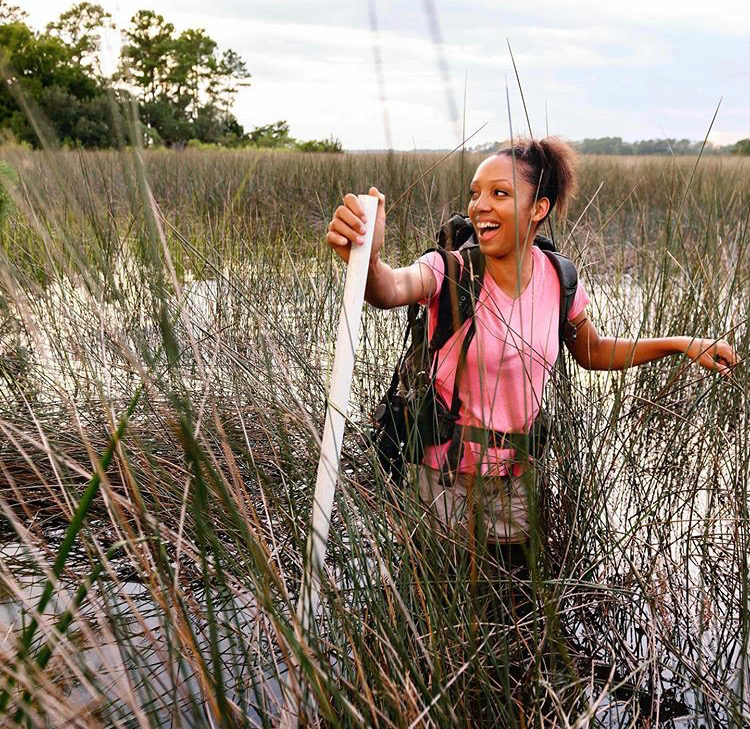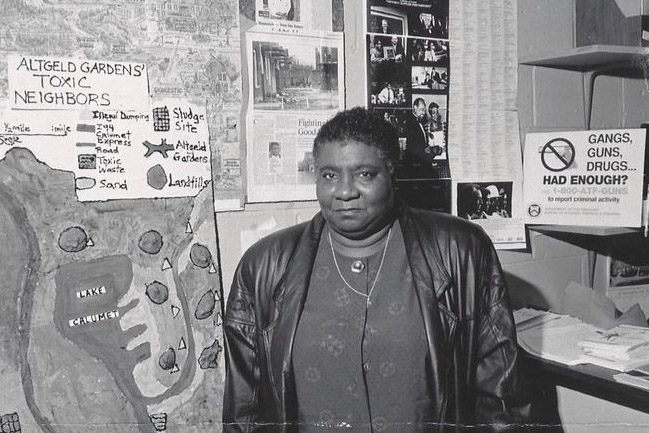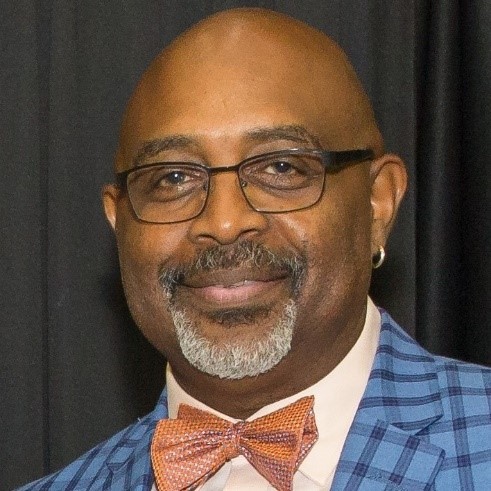Many Voices for Conservation and the Environment: Tykee James
 Continuing our series focusing on the contributions of historically under-recognized groups to conservation and environmental advocacy, this month we are featuring Tykee James, Government Affairs Coordinator at Audubon and a co-founder of Black Birders Week. During last year's inaugural event, James moderated Audubon's virtual "Birding While Black" conversations with young Black birdwatchers to hear their stories of discovering birds and their unique experiences of birding while Black in America.
Continuing our series focusing on the contributions of historically under-recognized groups to conservation and environmental advocacy, this month we are featuring Tykee James, Government Affairs Coordinator at Audubon and a co-founder of Black Birders Week. During last year's inaugural event, James moderated Audubon's virtual "Birding While Black" conversations with young Black birdwatchers to hear their stories of discovering birds and their unique experiences of birding while Black in America.
Born in Philadelphia, James moved around the country several times with his family, living in Wisconsin, California, and Texas, before returning to his hometown in 2011. Back in Philadelphia, a serious asthma attack triggered concerns about air pollution and the environment, and he began work as a naturalist and public educator at Philadelphia's Cobbs Creek Environmental Center. He also served as an environmental policy advisor to a Pennsylvania State Representative before moving to Washington, DC in 2018.
James joined the staff of the National Audubon Society in December of 2018 and found his passion in organizing bird walks with members of Congress and their staff to share his deep connection with nature and highlight environmental issues on behalf of the Audubon organization. He is also the host of the On Word for Wildlife podcast hosted by the Wildlife Observer Network.
Tykee James is a leading voice for equity and inclusion within the Audubon organization and in the wider birding community. According to Audubon, "James always finds a way to advocate for birds and the environment through the lenses of visibility and racial politics."
We at Duval Audubon Society applaud and support James' efforts to make birding more inclusive, and we are committed to making sure everyone feels welcome at any and all of our activities.
Many Voices for Conservation and the Environment: Corina Newsome
 Continuing our series focusing on the contributions of historically under-recognized groups to conservation and environmental advocacy, this month we are featuring ornithologist Corina Newsome, whose work as a co-founder of Black Birders Week brought her to national attention in the summer of 2020. She and several other Black scientists organized the event in response to an incident in New York’s Central Park in which a Black birder’s confrontation with a white woman who refused to put her dog on a leash as required by park rules went viral. Black Birders Week was conceived as a way to not only highlight Black contributions to STEM (science, technology, engineering, and mathematics), but also normalize the fact that Black people ARE birders, scientists, and naturalists. Presentations addressed the Black experience in nature, noting in particular the lack of representation in the birding community that has often made Black people feel uncomfortable and less willing to enjoy the outdoors and nature.
Continuing our series focusing on the contributions of historically under-recognized groups to conservation and environmental advocacy, this month we are featuring ornithologist Corina Newsome, whose work as a co-founder of Black Birders Week brought her to national attention in the summer of 2020. She and several other Black scientists organized the event in response to an incident in New York’s Central Park in which a Black birder’s confrontation with a white woman who refused to put her dog on a leash as required by park rules went viral. Black Birders Week was conceived as a way to not only highlight Black contributions to STEM (science, technology, engineering, and mathematics), but also normalize the fact that Black people ARE birders, scientists, and naturalists. Presentations addressed the Black experience in nature, noting in particular the lack of representation in the birding community that has often made Black people feel uncomfortable and less willing to enjoy the outdoors and nature.
From a young age, Ms. Newsome was interested in wildlife and nature and spent hours poring over old National Geographic issues at her grandmother’s house. But her concept of the career opportunities that might be available to her in the field were limited: all the scientists she saw in books and on TV were white, and it wasn’t until she was a teenager that she encountered a Black person who was working as a zookeeper. She was encouraged to do an internship at her local zoo, and only then realized that a career as a wildlife biologist was possible for her.
 Ms. Newsome studied zoology as an undergraduate and began her professional career as a zookeeper at the Nashville Zoo, but was inspired to pursue graduate studies in ornithology after learning about Blue Jays in a field ornithology course. Her research specialty centers around the conservation of MacGillivray's Seaside Sparrows, a species threatened by climate change, sea level rise, and predation that lives in the coastal marshes of South Carolina, Georgia, and Florida. She has shared personal experiences of feeling uncomfortable while conducting her research in the field, and always makes sure that her binoculars and other equipment are visible to make her appear more official and avoid possible confrontations with people who may not think she belongs.
Ms. Newsome studied zoology as an undergraduate and began her professional career as a zookeeper at the Nashville Zoo, but was inspired to pursue graduate studies in ornithology after learning about Blue Jays in a field ornithology course. Her research specialty centers around the conservation of MacGillivray's Seaside Sparrows, a species threatened by climate change, sea level rise, and predation that lives in the coastal marshes of South Carolina, Georgia, and Florida. She has shared personal experiences of feeling uncomfortable while conducting her research in the field, and always makes sure that her binoculars and other equipment are visible to make her appear more official and avoid possible confrontations with people who may not think she belongs.
In the fall of 2020, she also became Georgia Audubon Society’s Community Engagement Manager, and has founded several programs aimed at encouraging high school students from underrepresented demographics to consider wildlife-centered careers. Her mission is “to center the perspectives and leadership of historically marginalized communities in wildlife conservation, environmental education, and exploration of the natural world.”
We at Duval Audubon Society recognize the value of diverse voices, and are committed to creating an equitable and inclusive environment. Our activities are open to everyone who is interested in birds and nature - all are welcome!
Many Voices for Conservation and the Environment: Hazel M. Johnson
 Continuing our series focusing on the contributions of historically under-recognized groups to the conservation and environmental advocacy movement, this month we are highlighting the work of Hazel M. Johnson. Known as “The Mother of Environmental Justice” for her grassroots efforts to combat environmental racism, Johnson was a working-class woman who lived in a housing project managed by the Chicago Housing Authority on the South Side of Chicago for most of her adult life.
Continuing our series focusing on the contributions of historically under-recognized groups to the conservation and environmental advocacy movement, this month we are highlighting the work of Hazel M. Johnson. Known as “The Mother of Environmental Justice” for her grassroots efforts to combat environmental racism, Johnson was a working-class woman who lived in a housing project managed by the Chicago Housing Authority on the South Side of Chicago for most of her adult life.
Ten years after her husband died of lung cancer in 1969, she became aware of the high rate of chronic health problems like respiratory and skin conditions among area residents, including her own children. She realized that these illnesses were likely caused by exposure to toxic fumes from local steel mills, refineries, and chemical companies, asbestos used in the construction of the buildings they lived in, and contaminated drinking water. In addition, the housing project itself was built on top of land that had previously been used as a toxic sludge dump for the Pullman Motor Company. Residents of the area were found to have the highest incidence of cancer in the city of Chicago.
 With information collected by going door-to-door in her community, Johnson began to call on city and state health departments to investigate industrial pollution. In 1982 she founded a nonprofit organization called People for Community Recovery (PCR), which pushed for epidemiological studies of the effects of environmental pollution on area residents. One of the group’s early successes was the introduction of water and sewer lines in the community to replace the well water they had been relying on, which had been found to be contaminated with cyanide and other toxins.
With information collected by going door-to-door in her community, Johnson began to call on city and state health departments to investigate industrial pollution. In 1982 she founded a nonprofit organization called People for Community Recovery (PCR), which pushed for epidemiological studies of the effects of environmental pollution on area residents. One of the group’s early successes was the introduction of water and sewer lines in the community to replace the well water they had been relying on, which had been found to be contaminated with cyanide and other toxins.
Johnson also focused a great deal of her efforts on educating people in her community about the environmental hazards they all faced every day. Her work on environmental justice issues led to national attention, and she was selected to serve on the US Environmental Protection Agency’s newly established National Environmental Justice Advisory Council. In 1994, the work of the council resulted in President Clinton’s Executive Order on Environmental Justice, which directed federal agencies to identify and address the disproportionately high and adverse human health or environmental effects of their actions on minority and low-income populations. The order also directed each agency to develop a strategy for implementing environmental justice.
Hazel M. Johnson passed away in 2011 but her legacy lives on. The People for Community Recovery organization continues the work that Johnson began, and is now run by her daughter Cheryl Johnson.
Many Voices for Conservation and the Environment: James A. Richardson, II
 Continuing our series focusing on the contributions of historically under-recognized groups to conservation and environmental sciences, this month we are featuring James A. Richardson, II, who is the Program Administrator for the City of Jacksonville’s Environmental Protection Board (JEPB). Richardson has held the position for nearly nine years where he manages the day-to-day administration of the nine-member board, which has regulatory responsibility for issues associated with air and water pollution as well as odor and noise in Duval County. He also coordinates all public education and community outreach programs for the JEPB.
Continuing our series focusing on the contributions of historically under-recognized groups to conservation and environmental sciences, this month we are featuring James A. Richardson, II, who is the Program Administrator for the City of Jacksonville’s Environmental Protection Board (JEPB). Richardson has held the position for nearly nine years where he manages the day-to-day administration of the nine-member board, which has regulatory responsibility for issues associated with air and water pollution as well as odor and noise in Duval County. He also coordinates all public education and community outreach programs for the JEPB.
Richardson is a proud native of Jacksonville and has a long history of engagement with the local community. Before he joined the City, he worked with the United Way of Northeast Florida and JEA. He was the first African American to become the Chair of the Board for the Girl Scouts of Gateway Council, which serves more than 19,000 members in 35 counties across North Florida. He also served as the Founding Board Chair for Groundwork Jacksonville, the organization working to establish the Emerald Trail to connect Jacksonville’s urban core neighborhoods. Richardson has also served as a member of the board of trustees for Jacksonville’s Museum of Science and History (MOSH) and board of directors for the Northeast Florida Region of the U.S. Green Building Council, an organization that offers education and certification programs to encourage environmentally friendly building practices. He currently serves on the board of trustees for the Cummer Museum of Art & Gardens, board of directors of the Timucuan Parks Foundation and the North Florida Clean Fuels Coalition and is Vice-President of the board of Florida Local Environmental Resource Agencies (FLERA), a statewide organization representing all of the local government environmental programs.
One of Richardson’s major responsibilities with the JEPB is spearheading the annual Environmental Symposium, which is presented in conjunction with the University of North Florida Environmental Center. The symposium, which brings together residents, business, government agencies, utilities and innovators in a forum designed to foster an atmosphere of cooperation in environmental achievement, is one of the largest environmental conferences in the state. Each year the symposium presents a unique opportunity for members of the community to interact with the regulatory agencies responsible for developing and implementing environmental policy. Attendees have an opportunity to better understand environmental goals for our community. The symposium provides valuable opportunities for communication and helps to further the goal of protecting our limited natural resources and improving the quality of life in Northeast Florida.
We are grateful for his many years of dedication to the Jacksonville community and for his commitment to protecting and preserving the environment in Northeast Florida.
Many Voices for Conservation and the Environment: MaVynee Betsch
Continuing our series focusing on the contributions of historically under-recognized groups to conservation and environmental sciences, this month we are featuring MaVynee Betsch, known in Northeast Florida as “The Beach Lady” for her efforts to protect and preserve American Beach on Amelia Island in Nassau County.
 MaVynee Betsch was born in Jacksonville in 1935 to one of the preeminent Black families in the south. Her great grandparents were A.L. Lewis, a leading businessman, civic leader, and philanthropist, and Mary Kingsley Sammis, the great granddaughter of plantation owner Zephaniah Kingsley and his wife Anna Madgigine Jai, Kingsley’s former slave. A.L. Lewis was one of the co-founders of the Afro-American Life Insurance Company, the first insurance company in the state of Florida, and went on to become Jacksonville’s first Black millionaire. The town of American Beach was founded by the insurance company under the direction of Mr. Lewis in the 1930s as an oceanside retreat for Black notables as well as middle-class families, who were not free to visit just any beach in the Jim Crow south.
MaVynee Betsch was born in Jacksonville in 1935 to one of the preeminent Black families in the south. Her great grandparents were A.L. Lewis, a leading businessman, civic leader, and philanthropist, and Mary Kingsley Sammis, the great granddaughter of plantation owner Zephaniah Kingsley and his wife Anna Madgigine Jai, Kingsley’s former slave. A.L. Lewis was one of the co-founders of the Afro-American Life Insurance Company, the first insurance company in the state of Florida, and went on to become Jacksonville’s first Black millionaire. The town of American Beach was founded by the insurance company under the direction of Mr. Lewis in the 1930s as an oceanside retreat for Black notables as well as middle-class families, who were not free to visit just any beach in the Jim Crow south.
Ms. Betsch studied voice and piano at the Conservatory at Oberlin College and moved to Europe following her graduation in 1955, where she sang lead roles for the German State Opera and other companies. She returned to Jacksonville in 1962 and began to study and promote conservation and protection of the environment, donating her life savings to a variety of environmental causes, especially those involving wildlife like right whales, loggerhead turtles, and monarch butterflies.
In the 1970s, she made it her life’s mission to protect American Beach from development, fighting many battles to preserve the dunes that protect the beach from erosion, especially the 60-foot Nana dune (named by Betsch herself), which she successfully lobbied to become the property of (and forever protected by) the National Park Service. Through her tireless efforts, American Beach was also placed on the National Register of Historic Places, and she also developed plans for the American Beach Museum, which opened in 2014 and preserves the history of American Beach.
MaVynee Betsch was the unofficial historian of American Beach and up until just a few weeks before her death in 2005, enthusiastically gave Black History tours of the community for visitors. Ms. Betsch is truly a Northeast Florida conservation icon.
Page 1 of 3
